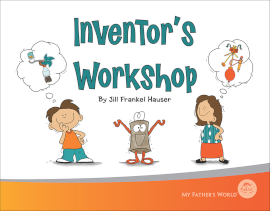Originally published under the title, Gizmos & Gadgets, Jill Frankel Hauser’s book Inventor’s Workshop has been reformatted and republished by My Father’s World. The book retains the original cartoon illustrations by Michael Kline and is printed in black and white.
Inventor’s Workshop is loaded with physics experiments and activities, many of which are super simple and can be done with household and kitchen supplies.
The book is divided into six sections:
- Laws of Motion
- Friction
- Gravity
- Balance
- Spinning
- Energy
Each section has three to five lessons, most including follow-up activities for even more experimentation. Lessons begin with an experiment or activity and then provide an explanation of the physics concept involved. Most lessons include real-life applications. For instance, the lesson on parachutes focuses on friction between the air and the open chute that creates an upward resisting force of air to slow the parachute’s descent. The same lesson also teaches the term “drag” and then explains the opposite concept of streamlined designs that reduce friction and drag as applied to airplanes, fish, and birds. In another lesson, students create a “Stop-and-Gobot” that slides on a string to illustrate friction—a ridge on the back of the Gobot providing friction when the string is tightened. The next page applies the same principle to bicycle brakes.
Some lessons include biographical snippets about famous inventors and scientists, such as Isaac Newton, the Wright brothers, George de Mestral (inventor of Velcro™), and Donald Duncan (creator of the Duncan yo-yo™).
Page 5 lists resources you will need, such as nails, nuts and bolts, corks, paper plates, plastic soda bottles, plastic straws, marbles, clay, coat hangers, string, tape, and rubber bands. There’s nothing exotic or hard to get on the list!
Three examples of the simplest activities are experimenting with kinetic energy on playground swings, making two identical paper airplanes and throwing them with different amounts of force, and making a “wobble ball” by putting a marble-sized ball of clay in a balloon before it’s inflated and thrown to learn about the center of gravity.
The lesson on super spinners is typical of those that present a moderate amount of difficulty. Students create spinners with toothpicks, cardboard, various lids, paper plates, or whatever else comes to mind. The lesson includes brief information about ways to stabilize spinners and the application of torque.
The Marshmallow Catapult is an example of one of the few activities that require a little more skill. It might be a little tricky because it requires cutting two plastic soda bottles into particular shapes, creating a launch pad from a small box or index card (cut and taped into a box) that is mounted on a pencil, joining two pencils in a cross shape with rubber bands, and creating the right amount of tension on the catapult with more rubber bands. Follow-up activities have students try to create other types of catapults.
Young children can enjoy many of the activities, but the level of information for some activities seems most appropriate for students in grades three through five. With students in that age group, I might let them thumb through the book and choose which activities they want to try. Fourth and fifth graders should be able to do some with minimal supervision. (Note that My Father’s World includes both Inventor’s Workshop and Kitchen Chemistry in their third-grade course package titled World Changers.)
Summary
Most activities in Inventor’s Workshop require a minimal amount of time and are great for a change of pace from more formal science or even just for fun.








